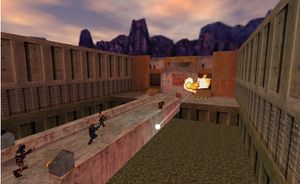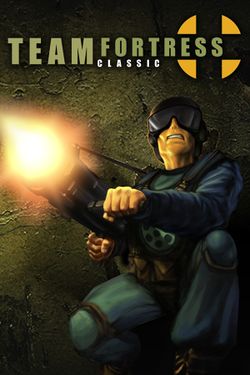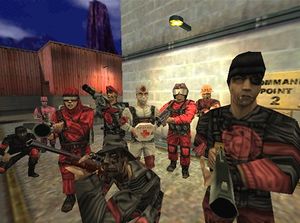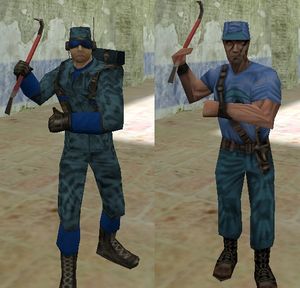Difference between revisions of "Team Fortress Classic"
(changed goldsource back to goldsrc..goldsrc is the actual name of the engine, goldsource is how its pronounced) |
m (tf2 was originally a mod) |
||
| Line 53: | Line 53: | ||
==Development== | ==Development== | ||
| − | Before ''Team Fortress Classic'' there was ''[[Team Fortress]]'', a 1996 ''QuakeWorld'' mod. '' | + | Before ''Team Fortress Classic'' there was ''[[Team Fortress]]'', a 1996 ''QuakeWorld'' mod. ''Team Fortress'''s developers were working on ''[[Team Fortress 2]]'' as a mod, but later joined [[Valve software]] and ported the original as a mod for ''Half-Life'' called ''Team Fortress Classic'' in April of 1999. Despite the company's 1998 statement that ''Team Fortress 2: Brotherhood of Arms'' would be released "soon," the game remained in development of one form or another for eight years until its release on 10 October 2007, and has been on ''Wired'' magazine's top ten vaporware list every year since 2001. |
Since ''Team Fortress Classic'''s release in 1999, Valve has introduced various changes into the game. The updates tweaked the game's balance and on occasion added new content, such as new levels. A particularly large update was released on 8 June 2000, which introduced several new levels and game modes, a new GUI menu interface and new player models, and optimized the game's netcoding for smoother, faster play. With this release, the game was renamed to ''Team Fortress 1.5''. In July 2004, the game was migrated into Valve's Steam system, in which a number of additional features were added. For much of its early history, ''Team Fortress Classic'' was second only to ''Counter-Strike'' as the most played and popular of online games. | Since ''Team Fortress Classic'''s release in 1999, Valve has introduced various changes into the game. The updates tweaked the game's balance and on occasion added new content, such as new levels. A particularly large update was released on 8 June 2000, which introduced several new levels and game modes, a new GUI menu interface and new player models, and optimized the game's netcoding for smoother, faster play. With this release, the game was renamed to ''Team Fortress 1.5''. In July 2004, the game was migrated into Valve's Steam system, in which a number of additional features were added. For much of its early history, ''Team Fortress Classic'' was second only to ''Counter-Strike'' as the most played and popular of online games. | ||
Revision as of 11:04, 4 June 2011
Team Fortress Classic, also known as Team Fortress 1.5, usually abbreviated as TFC, is the predecessor of Team Fortress 2 and a port of the original Team Fortress, originally a mod for the popular game Quake, to the Half-Life engine.
Team Fortress Classic is a team-based multiplayer first-person shooter video game developed by Valve. A remake of the Team Fortress modification for Quake, Team Fortress Classic was originally released for Windows on May 30, 1999 as a free addition to Half-Life. A standalone version was later released with Valve's Steam system in 2003. The development of Team Fortress Classic was led by John Cook and Robin Walker, the designers of the original Team Fortress modification.
It was originally announced in 1999 and was powered by Valve's GoldSrc engine. The designers of the Team Fortress modification had been hired by Valve to develop Team Fortress 2 on their engine, but they initially remade their original work on the GoldSource engine to help demonstrate its moddability. The game itself involves a number of teams, each with access to nine classes, competing in a variety of scenarios such as Capture the Flag, VIP protection and Territorial Control. In June 2000, the game underwent a significant upgrade, adding new player character models and game modes. As of 2008, the game is one of the ten most played Half-Life modifications in terms of userbase according to GameSpy.
Gameplay
Team Fortress Classic revolves around two or more teams competing in a variety of game modes with players selecting one of nine classes to play as. Typically, players have the choice of two equal teams, red and blue, although certain game modes allow for more than two teams with access to different classes. Each game can sustain a maximum of 32 players. The way a player acts in a game is defined by which class they select, with each class having their own strengths and weaknesses. As such, Team Fortress Classic relies heavily on teamwork between players of different classes.
Game modes
Team Fortress Classic supports numerous types of play, with distinct objectives for teams of players to pursue.

In capture the flag levels, the objective for both teams is to capture the enemy flag and return it to their base while preventing the opposing team from doing the same. Some maps of this type have twists on this formula, such as having multiple flags and requiring a team to capture them all, or requiring a team to perform a task such as disabling security grids before being able to access the flag. There is also reverse CTF in which you must bring your flag to the enemy base and capture the flag in the enemy base.
These maps consist of several command points that must be captured, typically either by standing on the command point or bringing a flag to the command point. Teams are awarded points at set intervals for each command point they control.
- Attack and Defend
Attack and defend maps, a variation of territorial control, feature one team trying to capture several command points in sequence, while the other team defends each command point from capture.
- Escort
In escort maps, the players are split into three teams—a single VIP, the VIP's bodyguards and a group of assassins. The goal of escort maps is for the bodyguards to escort the VIP to a given point on the map, while the assassins attempt to kill the VIP before he gets there.
Classes
There are nine standard classes in Team Fortress Classic that a player can select. Each class is equipped with at least one unique weapon and often armed with a secondary weapon such as a Shotgun or Nailgun. In addition, all classes are armed with a melee weapon—usually a Crowbar—as well as grenades with a variety of effects depending on the class a player has chosen. In escort levels, a single player can assume the role of a civilian, armed only with an umbrella, and must be escorted by the rest of the team across the level.
Development
Before Team Fortress Classic there was Team Fortress, a 1996 QuakeWorld mod. Team Fortress's developers were working on Team Fortress 2 as a mod, but later joined Valve software and ported the original as a mod for Half-Life called Team Fortress Classic in April of 1999. Despite the company's 1998 statement that Team Fortress 2: Brotherhood of Arms would be released "soon," the game remained in development of one form or another for eight years until its release on 10 October 2007, and has been on Wired magazine's top ten vaporware list every year since 2001.
Since Team Fortress Classic's release in 1999, Valve has introduced various changes into the game. The updates tweaked the game's balance and on occasion added new content, such as new levels. A particularly large update was released on 8 June 2000, which introduced several new levels and game modes, a new GUI menu interface and new player models, and optimized the game's netcoding for smoother, faster play. With this release, the game was renamed to Team Fortress 1.5. In July 2004, the game was migrated into Valve's Steam system, in which a number of additional features were added. For much of its early history, Team Fortress Classic was second only to Counter-Strike as the most played and popular of online games.
Trivia
- On the initial page for the Engineer Update, a screenshot of the original Team Fortress Classic class models as well as a young Dell Conagher with the Engineer from Team Fortress Classic can be seen. This, as well as the Sniper's Civilian bobblehead having the Team Fortress Classic logo on its base, may indicate that Team Fortress Classic and Team Fortress 2 take place in the same universe.
- Unlike in Team Fortress 2, Team Fortress Classic contained several references (and re-used content) from Half-Life. The most striking of which was the Hunted map, instead of being a remake of the original Hunted President from Team Fortress, it was a conversion of a segment of the Half-Life campaign which involved navigating past several Sniper nests. No such official content has been made for Team Fortress 2, and in fact, one map shares a name with the original Half-Life deathmatch, but has otherwise nothing in common.
- Fortress Forever, a free mod for Half-Life 2's Source engine, was created to port the gameplay and mechanics of Team Fortress Classic over to the Source Engine and give the owners of Source games the ability to experience the Gold-Source classic. It is the most popular mod fulfilling this function as of yet, but gameplay and mechanics are slightly different from the original.
- On August 24, Team Fortress' birthday, grenades will be replaced with presents if the
tfc_birthdaycvar is set to 1.
See also
External links
- Wikipedia: Team Fortress Classic
- Team Fortress Classic at the official Steam website.
- Fortress Forever
| |||||||||||



